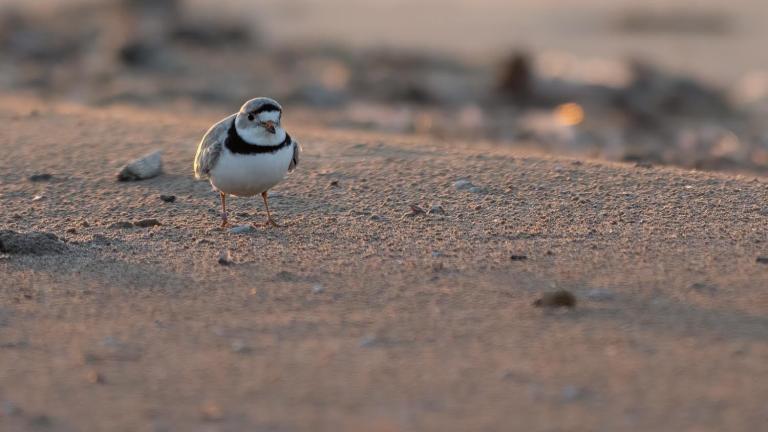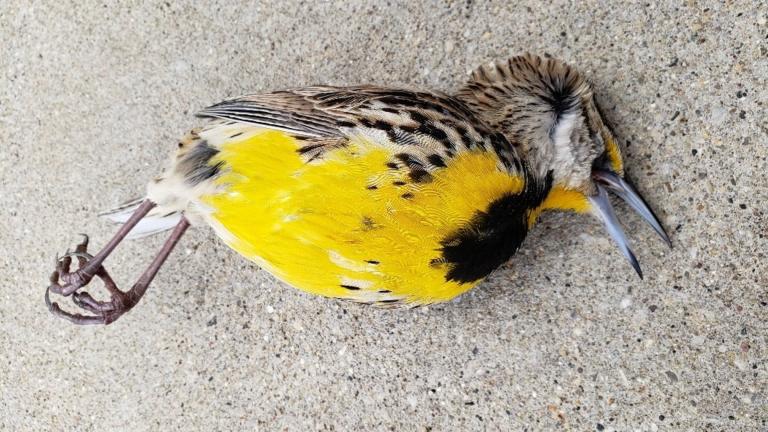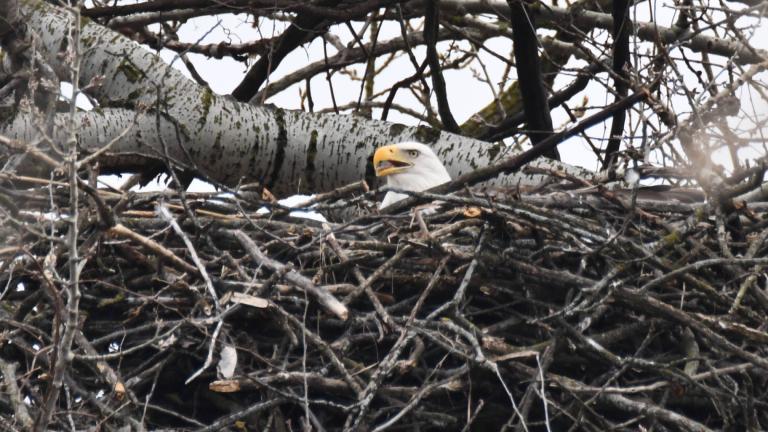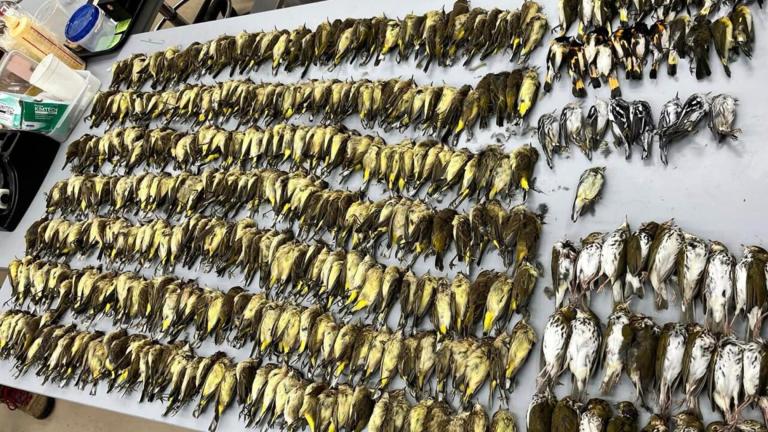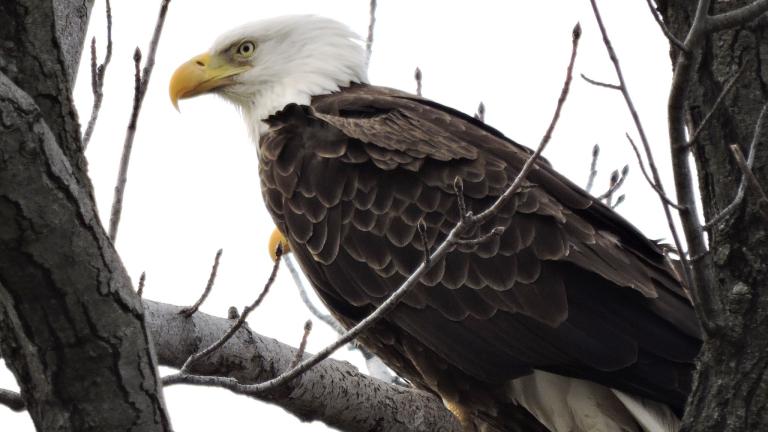 A team at the Field Museum processes birds killed in collisions with McCormick Place during a massive migratory wave Oct. 4-5, 2023. (Daryl Coldren / Field Museum)
A team at the Field Museum processes birds killed in collisions with McCormick Place during a massive migratory wave Oct. 4-5, 2023. (Daryl Coldren / Field Museum)
The headlines last week were shocking: 1,000 birds killed after colliding with McCormick Place Lakeside Center during a massive migratory wave Wednesday night into Thursday morning.
But the carnage didn’t end there, and it wasn’t limited to the lakefront.
For every dead or injured bird found at McCormick Place by a team from the Field Museum, which routinely scours the convention center’s grounds for victims, volunteers with Chicago Bird Collision Monitors (CBCM) picked up an equal number of casualties elsewhere downtown. And in addition to the birds found on sidewalks, plazas and parkways, monitors received huge bags of dead birds that had been collected from rooftops of buildings by maintenance staff, said Annette Prince, the organization’s executive director.
There was no rest for weary monitors over the weekend.
More than 500 birds were found on Friday, another 500-plus on Saturday, around 350 on Sunday and approximately 100 birds on Monday, according to Prince.
“In the past five days, CBCM has collected as many birds as we might find in an entire season of monitoring,” she said.
Those were just the birds monitors came across on their routes or were notified of via the organization’s hotline, she added. Countless dead or injured birds went unnoticed or were scooped up by predators.
You ever wondered what a couple seconds of a tiny portion of sky would look like during a morning with 180,000+ migrating warblers?
That’s oddly specific, but wonder no more! pic.twitter.com/55no7Gp6XD
— Marky Mutchler (@MarkyMutchler) October 6, 2023
While the full tally of dead will never be known, wildlife advocates are certain of one thing: The vast majority of losses were preventable.
Members of Chicago’s birding community have been waging a decades-long campaign to educate residents and officials about the dangers the city’s bright lights and glass buildings pose to birds.
“It is shouting into the void sometimes, our own bird echo chamber,” said Edward Warden, president of the Chicago Ornithological Society.
Though headway has been made, largely in the form of a “Lights Out” program subscribed to by many of the city’s most dangerous buildings, the voluntary nature of such mitigations has limited their effectiveness.
McCormick Place, for one, has been told for 30 years that it’s a major bird killer, and that Lights Out would save lives, but the building’s management frequently opts not to comply, said Prince.
In a statement posted to social media and on its website after last week’s mass mortality event, the Metropolitan Pier and Exposition Authority (MPEA), which owns McCormick Place and Navy Pier, said, in part: “Lighting at McCormick Place is turned off unless needed for our employees, clients or visitors. It is important to understand that there is an event going on at Lakeside Center this week, and thus the lights have been on when the space is occupied. As soon as the space is unoccupied, the lights have been turned off.”
Commenters disputed the building’s commitment to Lights Out and one resident of a nearby building sent WTTW News a photo of the convention center aglow after-hours on Friday.
McCormick Place learned that on Wednesday night an extremely large number of migratory birds died after colliding into the Lakeside Center and other campus buildings.
For information on McCormick Place's Migratory Birds Policy please visit: https://t.co/IbpmLEM4Rd pic.twitter.com/kGdnOk9fTP
— McCormick Place (@McCormick_Place) October 6, 2023
Public pressure is mounting for McCormick Place to do right by birds.
Advocates point to the example of New York City’s Javits Center, billed as one of the busiest convention sites in North America. The center famously underwent a $500 million renovation in 2014, which included a retrofit of bird-friendly glass. New York City Audubon has since reported a 90% drop in bird strikes at Javits — formerly the city’s top bird killer.
A spokesperson for MPEA told WTTW News a variety of solutions were on the table.
“MPEA has been exploring a number of different options to renovate Lakeside Center, with focus on steps that can be taken to address this issue, both in the long-term with potential replacement of glass, and the short-term.”
The MPEA board next meets on Oct. 24, at 9 a.m.
While McCormick Place may be the highest-profile site for bird collision injuries and deaths, it’s far from the only culprit. The Apple Store — a glass box on the Chicago River — is another notable killer, as is the BMO Harris tower, which has consistently ignored pleas to join Lights Out, according to Prince.
“It’s nothing but excuses from them,” she said of BMO.
By now, advocates like Prince, Warden and Judy Pollock of the Chicago Audubon Society had hoped to have the force of law behind their efforts to curtail bird strikes and deaths.
Bird Friendly Chicago, a coalition of Chicago birding organizations and the Illinois Ornithological Society, had lobbied City Council to pass a bird-friendly ordinance. Among the goals, Pollock said, was to mandate bird-friendly design for new buildings.
The coalition found a champion in Ald. Brian Hopkins (2nd Ward) and a comparatively receptive administration under Mayor Rahm Emanuel, she said, but they couldn’t quite seal the deal, legislatively.
In 2020, City Council did pass an action that directed the Department of Planning and Development to create stronger bird-friendly design measures within its Sustainable Development Policy — a policy that only applies to new developments in need of approval from the Department of Planning and Development.
The creation of those guidelines languished under Mayor Lori Lightfoot, particularly once the COVID-19 pandemic hit.
Stakeholders including Prince and Pollock have continued to press the Department of Planning and Development to revise the policy and were told over the summer that an announcement regarding new guidelines was imminent.
Responding to a request for comment from WTTW News, Peter Strazzabosco, deputy commissioner within the department, confirmed a rollout of the new guidelines would take place later in 2023. The public will have an opportunity to comment and suggest changes before the guidelines are finalized, he said.
Even once these anticipated guidelines are implemented, Chicago will still lag behind its peers when it comes to protecting birds, said Carl Giometti, an architect and former president of Chicago Ornithological Society.
Among the drawbacks to Chicago’s approach, he said: the policy only applies to buildings/developments under review by the Department of Planning and Development, which represents a fraction of projects in the city; the department doesn’t have the staff to oversee enforcement; and policies can change or exceptions can be granted.
“So here we are today, seeing photos of thousands of dead birds littering the streets of the city. Even if a full ordinance was passed today, it would be decades until a critical mass of buildings were treated with bird-friendly measures,” Giometti said in a lengthy social media post. “I can assure you, this won’t be our last mass mortality event.”
Coming to WTTW News on Thursday: A look at the future of bird-friendly design in Chicago.
Contact Patty Wetli: @pattywetli | (773) 509-5623 | [email protected]

